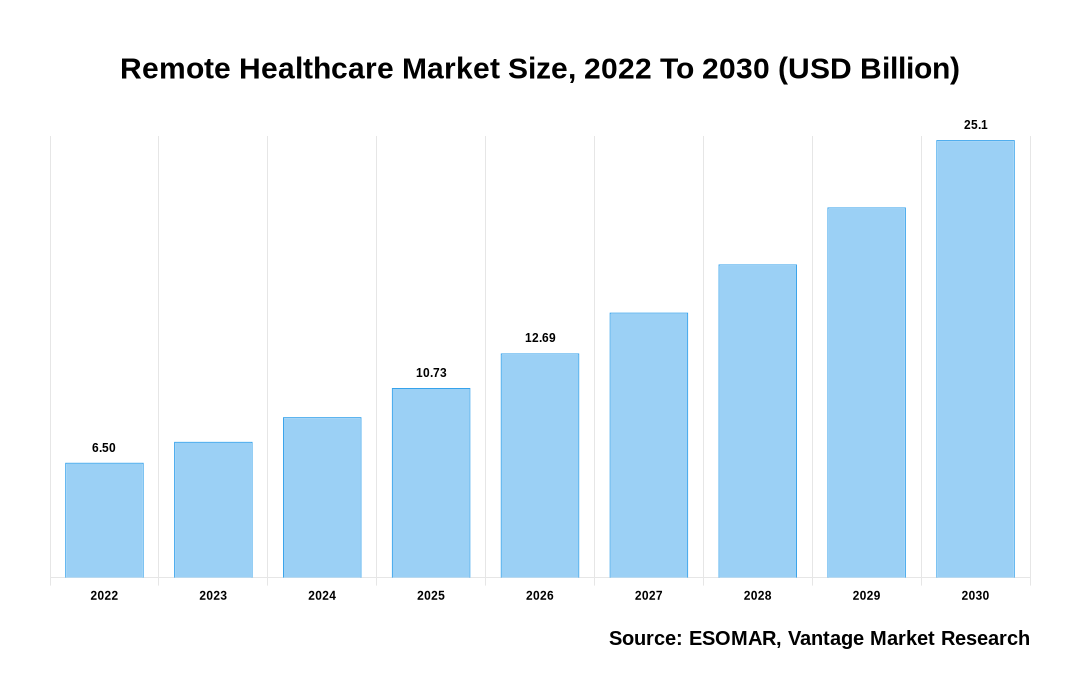Global Remote Healthcare Market
As stated in our extensive report, the Global Remote Healthcare Market accounted for USD 6.5 Billion in 2022 and is projected to reach a value of USD 25.1 Billion by 2030.
The Remote Healthcare market refers to using technology and telecommunication to deliver healthcare services remotely. It includes various technologies such as telemedicine, telehealth, remote patient monitoring, and mobile health (mHealth). The market has been growing steadily over the past few years, driven by the increasing adoption of digital health solutions, technological advancements, and the need for more accessible and convenient healthcare services. The COVID-19 pandemic has also accelerated the adoption of Remote Healthcare solutions, highlighting the importance of remote consultations and monitoring to reduce the risk of infection.
Furthermore, Remote Healthcare solutions are constantly evolving, with advancements in various technologies such as artificial intelligence, Internet of Things (IoT), and wearable devices. These technologies enable remote monitoring, data analysis, and personalized healthcare delivery, further driving market growth. In addition, remote patient monitoring devices and platforms have gained traction in the market. These devices enable healthcare providers to remotely monitor patients’ vital signs, track health conditions, and provide timely interventions. This demand is driven by the increasing prevalence of chronic diseases and the need for continuous monitoring.
Click To Get a Free Sample On the Research Study

Factors Influencing Global Remote Healthcare Market Growth
The growth of the global Remote Healthcare market can be attributable to the following:
- The rapid development and adoption of technology have played a crucial role in driving the growth of the Remote Healthcare market. Advances in telecommunication networks, internet connectivity, smartphones, wearable devices, and remote monitoring systems have made it possible to provide healthcare services remotely.
- The rising cost of healthcare services has led to the adoption of Remote Healthcare as a more cost-effective alternative. Remote Healthcare reduces the need for physical visits to healthcare facilities, thereby lowering costs associated with travel, waiting times, and hospital stays.
- The aging population and the increasing prevalence of chronic diseases have contributed to the growth of Remote Healthcare. Older adults often require frequent medical attention, and Remote Healthcare provides an efficient way to deliver care, especially in remote or underserved areas. Remote monitoring devices allow patients to monitor their vital signs, medication adherence, and other health parameters from the comfort of their homes, enabling early detection and prevention of complications.
- Patients increasingly prefer the convenience and flexibility of Remote Healthcare services. With Remote Healthcare, patients can access medical consultations and receive prescriptions without leaving their homes. This eliminates the need for travel, reduces waiting times, and provides access to healthcare professionals even in areas with shortages.
- The ongoing COVID-19 pandemic has further accelerated the growth of Remote Healthcare. Social distancing measures and the need to minimize in-person healthcare visits have led to increased adoption of telehealth services and virtual consultations.
- Many governments worldwide have recognized the potential benefits of Remote Healthcare and have implemented policies to promote its adoption. These initiatives include reimbursement policies for telehealth services, funding for technological infrastructure, and regulatory changes to support Remote Healthcare practices.
North America Region to Take Over the Market
North America is the largest region in the global Remote Healthcare market due to the high adoption rate of advanced healthcare technologies and increasing government initiatives. The US has been at the forefront of this market due to the highest healthcare spending in the world. The development of sophisticated mobile health applications and wearable devices has further led to penetration in the market. The region is also home to major players of Remote Healthcare such as Teladoc Health, Medical Guardian, and Honeywell Life Care Solutions. Furthermore, the aging population, high prevalence of chronic diseases, and rising demand for home healthcare services, especially in rural areas, have also played a major role in driving growth in this market. The COVID-19 pandemic has further accelerated the adoption of Remote Healthcare, as virtual consultations and telemedicine services became the new norm during lockdowns. Overall, with increasing awareness, technological advancements, and government support, North America is anticipated to dominate the global Remote Healthcare market in the coming years.
The Remote Healthcare market in the Asia Pacific region is expected to experience significant growth in the coming years. Several factors, including an increasing demand for healthcare services, a growing elderly population, advancements in technology, and the current COVID-19 pandemic are driving this growth. The Asia Pacific region also has a rapidly aging population, with countries such as Japan, South Korea, and China experiencing a significant increase in elderly individuals. Remote Healthcare can play a crucial role in providing healthcare services to this demographic, as it allows healthcare providers to monitor patients with chronic conditions and deliver personalized care remotely.
Conclusion
Overall, the Remote Healthcare market is expected to continue its growth trajectory in the coming years. Factors such as technological advancements, increasing healthcare costs, and the need for convenient and accessible healthcare services are likely to drive the market.
However, challenges such as data privacy and security concerns, reimbursement issues, and the digital divide in underserved areas must be addressed to fully realize Remote Healthcare’s potential.
The well-known players of the Global Remote Healthcare Market include Advanced ICU Care, BioTelemetry, Koninklijke Philips, Teladoc Health, Vivify Health, AirStrip Technologies, Medtronic, InTouch Technologies, American Well, Resideo Life Care Solutions, and others.
![[Market Research Reports] – Research Google News Blog | VMR.Biz](https://www.vmr.biz/wp-content/uploads/2022/12/logo-removebg-preview.png)











